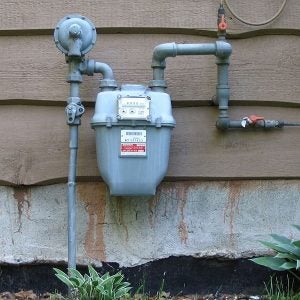 This blog was co-authored by Tim O’Connor and Ellison Folk, an Environmental Attorney at Shute, Mihaly & Weinberger.
This blog was co-authored by Tim O’Connor and Ellison Folk, an Environmental Attorney at Shute, Mihaly & Weinberger.
California utilities finally have a set of plans to cut methane leakage from the state’s natural gas pipelines. This is good news, but there are still a handful of improvements that could help make the state’s gas pipelines leak even less.
Methane leakage is a serious environmental and safety issue that afflicts the entire natural gas supply chain. Methane is a potent greenhouse gas that must be reduced if California is to reach is ambitious climate goals.
Even before the Aliso Canyon disaster attracted national attention, California passed a groundbreaking law (SB 1371) requiring public utilities to reduce natural gas emissions. Last June, the California Public Utilities Commissioned ruled utilities must adopt plans that implement 26 best practices (See Appendix B) to reduce methane emissions.
Most importantly, the CPUC’s decision requires more frequent surveying and more rapid repair of natural gas leaks. In particular, utilities are now required to survey their systems for leaks at least every three years, and they should conduct more frequent surveys of particularly problematic areas—such as those served by aging pipes that leak more frequently. The utilities must also repair their backlog of what are called “Grade three” leaks—leaks that do not present an imminent safety hazard but contribute substantially to greenhouse gas emissions. Previously, utilities focused primarily on repairing leaks that present a safety hazard, and as a result, the backlog of Grade three leaks has grown to the tens of thousands. While the repair of hazardous leaks remains the top priority, now utilities must also repair natural gas leaks that present an environmental hazard because of their impact on climate change.
On March 15 the utilities filed their methane reduction plans with the CPUC. While some aspects of the plans show great promise, there are four ways the utilities could more fully embrace the challenge of reducing methane emissions.
1. Set targets that align with the state’s methane goals
None of the plans show a clear path to achieving the state’s mandate of reducing methane emissions by 40 percent by 2030. Some utilities, such as Southwest Gas, propose to only reduce emissions by less than 1 percent. PG&E and Southern California Gas—the two largest emitters of methane—show reductions on the order of 18 to 19 percent. Even assuming the plans provide an accurate accounting of the reductions that their best practices will achieve, the utilities still have a long way to go to meet California’s goals.
2. Adopt institutional changes to ensure better identification and tracking of leaks
Given this gap, the plans must do more to execute best practices. For example, utilities could improve job training and job descriptions in order to ensure utilities are staffed with specialized experts who can use new and existing technologies to identify methane leaks. Utilities also need to improve the tracking and mapping of emissions to identify and focus on problem areas, and evaluate whether surveys and repairs are effective. Utilities can also improve their use of pilot projects and research and development to evaluate new technologies to enhance leak identification.
3. Invest in advancing methane detection technology
Since SB 137 was adopted, technological innovation in the field has expanded dramatically. Companies have developed highly sensitive stationary methane detectors that can be installed along pipelines and equipment susceptible to leakage. Mobile surveys though vans, drones, and aerial imaging can supplement traditional walking surveys with handheld monitors. Although some plans propose to pilot some of these new technologies, they contain no criteria for evaluating their effectiveness or assessing how they can be integrated into the utilities’ practices.
4. Make “super emitter” gas leaks a priority
One bright spot in the plans is a proposal by PG&E to prioritize the identification and repair of large methane leaks—so called “super emitters.” Studies indicate a small number of large leaks contribute disproportionately to natural gas emissions, even when not considered a safety hazard. Utilities can gain a lot by identifying these large leaks and repairing them within days or weeks, as opposed to the months or years.
[Tweet “Four ways California utilities can make a big dent in reducing methane emissions”]
PG&E proposes to conduct mobile surveys every year using sophisticated emissions detection equipment paired with high-tech computing programs to find large leaks and get them repaired quickly. Although not perfect, mobile surveys are a fast and cost-effective way to supplement walking surveys. These additional annual surveys will identify leaks that might have been missed, or have popped up in between less frequent walking surveys and continued to leak for years before being repaired.
No shortcuts when it comes to cutting gas leaks
By contrast, Southern California Gas has requested an exemption from the requirement that it survey its entire system every three years. Although SoCalGas proposes to conduct more frequent surveys of some of its aging pipelines, it does not integrate new and tested mobile technologies that could expand the area it surveys and increase the number of leaks found and repaired. Multiple studies and examples from utilities across the country confirm that combining of survey methods is the best way to ensure the largest number of leaks are identified, and SoCalGas should take a more innovative, proven approach to finding leaks and fixing them.
Because these SB 1371 plans are the first attempts by utilities anywhere to comprehensively address methane leakage, some may be inclined to give them a pass. However, these plans will set the stage for the next 12 years and it is important that we get this right from the outset. The plans do not need to be perfect, but they need to be effective. By their own projections, the plans will not even get us halfway to California’s 2030 target. The CPUC must ensure that the utilities do better and that they do so now.









